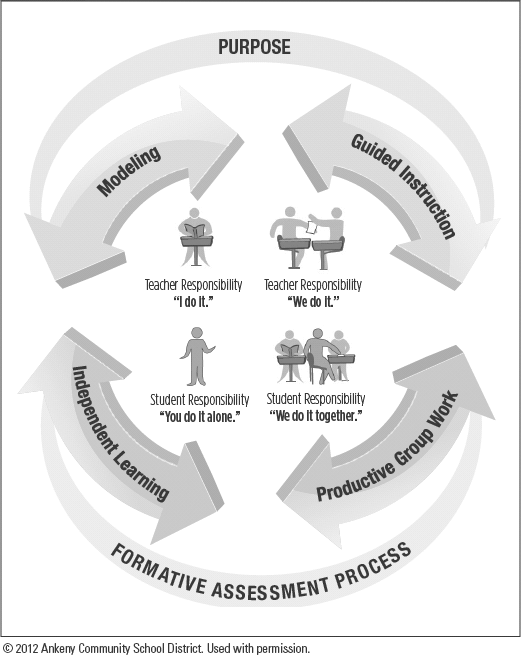Subica Hussain
Master of Arts in Teaching

Comprehension strategies enable the reader to understand better and construct the meaning of the text. The teacher introduces each strategy to equip the young readers with the necessary tools to comprehend the text well. For young readers to succeed the teacher should use the instructional approach the “Gradual Release of Responsibility Model.” The model can easily be remembered by the mnemonic “Show me, Help me, Let me” (Duke p. 100). The gradual release of responsibility is a scaffolding approach to teaching instruction. The model displays the shift of cognitive load from teacher to the learner in a step-by-step manner. For example, you ask somebody to ride a bicycle: to teach him you ride the bike and then hand over the bike to him and tell him to ride. Chances are he might fall, or he would get frustrated due to the lack of information he gets from the demonstration. Neglecting stages in between derails learning. The better approach would be to hold the rider’s hand and guide him through the riding experience until he is ready to ride independently.

During the “Modeling” stage, the teacher would demonstrate or model a particular comprehension strategy. The teacher would think aloud for students, which "helps make some invisible mental processes visible,” and apply the targeted learning skill (Duke p. 137). The learners at this time listen actively but do not participate in the instructed part. The modeling stage is all about explicitly stating the purpose of the strategy, “research strongly indicates that explicitly teaching comprehension strategies can improve students’ reading comprehension” (Duke p. 77). Students use the comprehension strategy as a tool for understanding the text in a meaningful way. The teacher introduces the comprehension strategy, for example, “Making Connections” that would help in understanding the text. Later, the teacher reinforces the strategy during shared, guided and independent practice. The teacher makes sure that each comprehension strategy is introduced one at a time, not all in one session.

During the second stage “Shared Practice,” the teacher invites learners to take part in the discussion of the fundamental ideas involved in learning comprehension strategy. The teacher and students are actively debating and building off each other's responses “promote exchanges that have a higher proportion of students talk: teacher-student-student-teacher….and so on” (Duke p. 70).
The third stage “Guided Practice,” leads to student collaboration among them. Students work in-group, and the teacher supports them through guided practice while circulating between the groups. At this stage, the teacher “pulls together a small group to provide extra help,” which can assist students who need additional support (Duke p. 108). The teacher can utilize this stage for differentiated instructions based on students’ needs. The class time should incorporate collaborative learning phase as a routine rather making it a special event. For example, in a class which students are engaged in reading an informational text, during the collaborative phase the students will have the opportunity to discuss the text by asking questions, making inferences, etc. The discussion will support the students later on when they would engage in the “Independent Practice ” phase.

During the “Independent Practice” phase, the students are required to demonstrate the learned skill or comprehension strategy independently. At this point, the students are vigorously engaged in applying the learned comprehension strategy, to an authentic task. As stated in Inside Information by Nell K. Duke, for students to join and complete the work, it is important that the task is authentic.
The “Gradual Release of Responsibility Model” is not linear, rather it operates in a cyclical fashion. “As texts and tasks become more complex, you cycle back to a greater level of responsibility”(Duke p. 99). The teacher can either model with another example or assign students to a different need based group. The whole point is the release of responsibility occurs gradually as the model implies.
Work Cited:
Duke, N. K. (n.d.). Inside information: Developing powerful readers and writers of informational text through project- based instruction.
Instructional Framework to Teach Comprehension Strategies to Young Readers

I am engaged in modeling, explicitly thinking aloud the comprehension strategy "Making Connections."
The student is actively engaged in reading and highlighting the important details in the text.
My teaching partner and I are supporting the students in the group during the "Guided Practice Stage."
The student is independently summarizing using her highlighted notes.
The act of decoding and pronouncing words is not reading. Many young readers fluently read the text. When you ask them what the text is about, they do not respond. Reading without comprehension is not reading. Research shows that students who get explicit instructions in the use of evidence-based comprehension strategies become active readers. They set a purpose for reading, make connections to existing schema, build mental images, predict, question themselves during reading, monitor their reading, summarize, and synthesize. Young readers use comprehension strategies to become active, purposeful readers. An active reader is involved in the thinking process, "Metacognition," a process in which the reader is metacognitive about his/her thinking while reading the text for information or pleasure. The analysis of Common Core State Standards requires students to use these evidence-based comprehension strategies.
